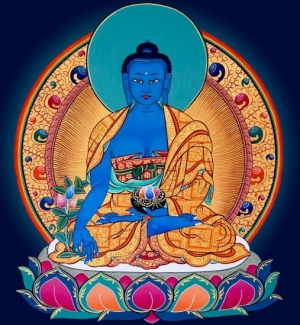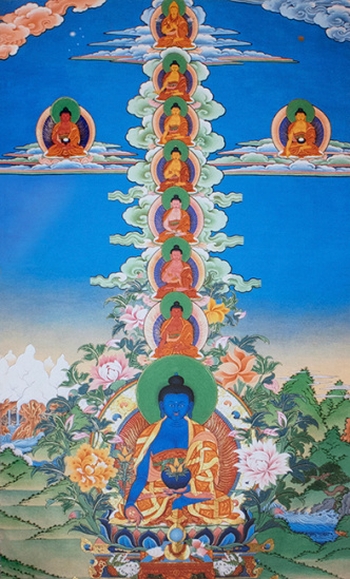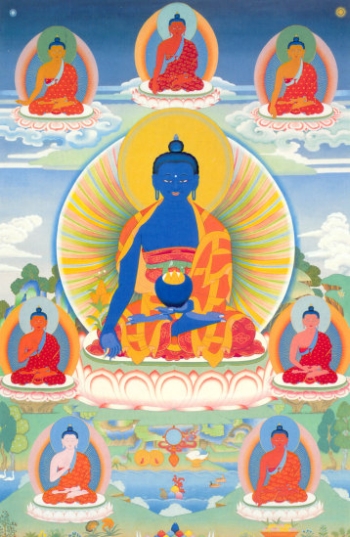Bhaiṣajyaguru | Healing Buddha
Bhaiṣajyaguru | Healing Buddha
Bhaiṣajyaguru, the Buddha named Master of Healing, is an important member of the Mahāyāna Buddhist pantheon. He has been worshiped predominantly in East and Central Asian traditions of Buddhist practice.
Concepts of healing played a fundamental role in early Buddhism:
Śākyamuni Buddha was sometimes given the epithet “supreme physician,” and the Buddhist teachings were termed the “king of medicines” for their ability to lead beings out of suffering:
In early Buddhist teachings, as in later times, the Enlightenment process was equated with the healing process.
Further, many monks were healers and physicians; such persons played a significant role in the spread of Buddhist teachings.
Thus, when the Mahāyāna pantheon began to take form in the centuries directly before and after the beginning of the Common Era,
several key figures were associated especially with healing abilities, both metaphorical and literal. Master of Healing ultimately was viewed as the most important figure of this group.
The principal scripture written about this Buddha, entitled:
Scripture on the Merits and Original Vows of the Master of Healing,
the Lapis Lazuli Radiance Tathāgata,
- is a work that eventually became best known in the Chinese version translated by Xuanzang in 650 CE.
As in other works of this type, most likely composed in the early centuries of the Common Era in the north-west borderlands of India,
the historical Buddha Śākyamuni serves as a pivot between the human realms and celestial spheres, in this instance revealing to his listeners the existence of the Enlightened celestial being Bhaiṣajyaguru.
Following a pattern often seen in such texts, the Buddha and his Pure Land are described, his vows to aid all beings are detailed, and various methods are explicated for invoking his beneficent force.
Here, Master of Healing is described as lord of a spirit realm located to the East, a land named Pure Lapis Lazuli, with level ground made of that radiantly blue stone, marked by roads of gold and various structures built of precious substances.
Like the celestial fields of other Buddhas such as Amitābha, this realm is a refuge from suffering;
it is an ideal site to listen without distraction to the pure principles taught by its lord, the Master of Healing, in association with the 2 leaders of his Bodhisattva assembly, Sunlight (Sūryaprabha) and Moonglow (Candraprabha).
Master of Healing’s 12 vows, first made when he set out to gain Enlightenment, cover a wide range of benefits to sentient beings:
The most widely known is the 6th vow, a pledge to alleviate the sickness and suffering of all beings. The fulfillment of this pledge forms the subject of much of the scripture.
Yet, while Master of Healing has pledged to aid all beings who are sick and suffering, he must be called upon in order to invoke this potent aid.
According to the scripture, methods of effective invocation range from the simple expedient of calling out his name to special rites involving prayer and worship before his image.
In the case of life-threatening disease, a complex rite is outlined in the scripture (and described in great detail in special ritual texts) -
- in which 49 cartwheel-shaped lamps are burned before 7 images of the Buddha for 49 days, with many other ritual acts performed in units of 7 or 49.
The number 7 (and its square, 49) is especially important in the Buddhist healing cults, most likely relating to the number of days in the intermediate state (antarābhava) between death and rebirth.
A fundamental feature of the healings bestowed by Bhaiṣajyaguru is the transformation of karma, that is, a concern for eradicating the patterned causes as well as the visible symptoms of suffering.
This sense of transformation pervades the scriptural and ritual traditions associated with the practice.
In this context, Master of Healing is especially important for his work in assisting beings to reach a momentous spiritual turning point known as the “aspiration to attain Enlightenment,” at which the drifting life is cast aside in order to seek spiritual fulfillment.
Standard images of Master of Healing depict him as a seated Buddha in monk’s garb, either having skin the rich blue color of lapis lazuli or having a golden complexion with a halo and aura of lapis lazuli-colored rays.
The Buddha holds a bowl or covered medicine jar on his lap with his left hand, while his right hand, resting on his right knee with palm outward, offers the medicinal myrobalan fruit;
sometimes he is standing, holding the medicine jar in his left hand, with right hand upraised in the gesture of the banishment of fear.
He is flanked by his Bodhisattva assistants, Sunlight and Moonglow, who stand in princely garb.
Encircling them are 12 Yakṣa generals, each of whom is said to command 7 000 troops, all in aid of the Buddha’s healing work.
In some East Asian traditions, these 12 generals are clearly depicted as lords of the 12 hours of the day and the 12 years of the Jupiter-based cycle.
The cosmic wholeness of this scene is striking:
with lapis lazuli at the center that radiates like the depths of space,
together with the 2 luminaries who are encircled by lords of time,
- it points to the profound nature of internal and external healing provided by this Buddha.
A somewhat later tradition, introduced to China in the early 8th century and eventually popular among Tibetans and Mongolians, focuses on 7 brothers identified as healing Buddhas, the senior physician among them being Bhaiṣajyaguru:
This group is often depicted with Śākyamuni Buddha, thus turning back to the roots of the Healing Buddha cult in the early tradition of Śākyamuni as spiritual healer.
The traditional mantra of Bhaiṣajyaguru, also known as Sangye Menla in Tibetan is:
Tadyata Om Bhekhandze Bhekhandze Maha Bhekhandze Randza Samudgate Soha
You can repeat also the Sanskrit version of Medicine Buddha dharani, as mentioned in the Sūtra:
Namo Bhagavate Bhaisajaya
Guru Vaidurya Prabha Rajaya
Tathagataya Arhate Samyakṣam-Buddhaya
Tadyatha Om Bhaisajye Bhaisajye Maha Bhaisajye
Samudgate Svaha


